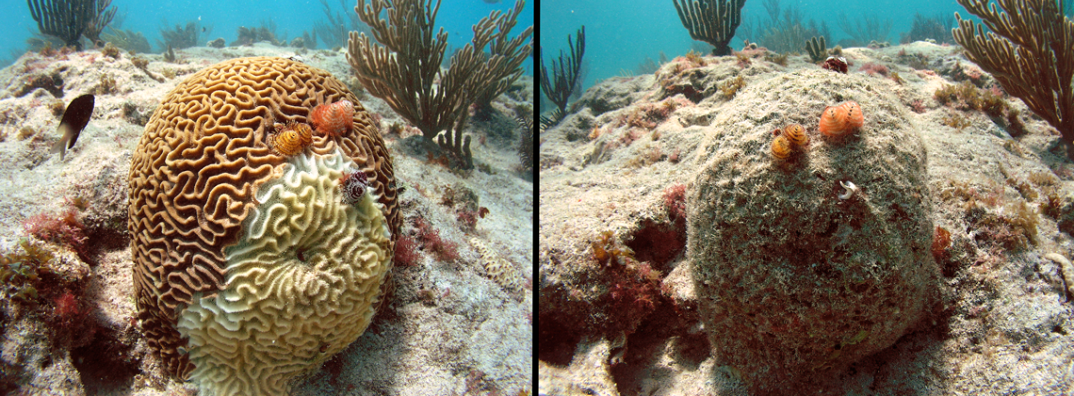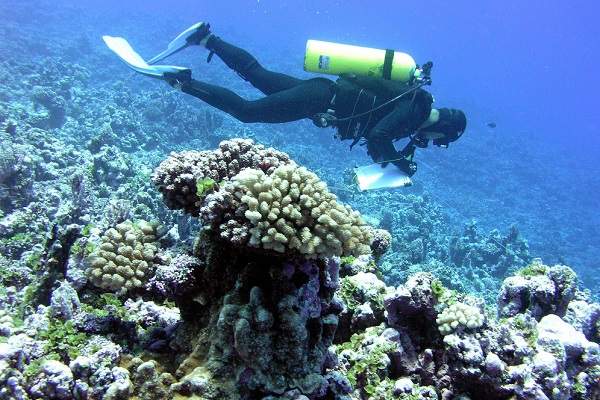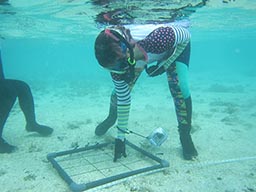- ABOUT US
- PROGRAM AREAS
- CONSERVATION APPROACH
- EDUCATION
- MULTIMEDIA
- The program can inform background or baseline levels of all coral diseases in a given jurisdiction as a reference point for local monitoring efforts.
- The program can provide “eyes-in-the-water” over a large stratified random sampling area. Monitoring scientists can then send local experts photos and Global Positioning System site locations of any coral colonies that are potentially affected by the disease.
- The program can provide data to local experts about sites with high coral density, coral cover, and the size of vulnerable coral species to inform local monitoring efforts.
- The program can provide subject matter expertise to help design a monitoring strategy to robustly survey for the disease.
- The program can provide contextual data about the impacts of mortality to coral populations by species where possible.
- Because of the vast geographic coral reef area that is surveyed and the limited frequency and timing of surveys, the monitoring program is not ideal for tracking the progression of stony coral tissue loss disease. In the Atlantic and Caribbean, jurisdictions are surveyed every other year. In the Pacific, jurisdictions are surveyed every three years. Additionally, the majority of surveys are completed during the summer months. Monitoring protocols that survey annually throughout more months of the year would be needed to properly capture disease incidence.
- The National Coral Reef Monitoring Program design can be supplemented by local partners who use the same methods to monitor more frequently. This would allow data from partners and the National Coral Reef Monitoring Program to be comparable to assess disease status and trends.
- Additionally, training for the National Coral Reef Monitoring Program does not currently include stony coral tissue loss disease identification, and many surveyors are not trained in specific disease identification. The monitoring program broadly captures the presence or absence of all types of coral diseases and is not specifically designed to identify stony coral tissue loss disease.
- However, as previously mentioned, monitoring surveyors can document disease presence and share with local partners to identify stony coral tissue loss disease.
How Can the National Coral Reef Monitoring Program Help Inform Stony Coral Tissue Loss Disease Monitoring?
by Erica K. Towle, Ph.D., National Coral Reef Monitoring Program Coordinator

Atlantic and Caribbean coral reefs are facing an unprecedented outbreak of stony coral tissue loss disease. This disease is characterized by its rapid spread, swift tissue loss, and high mortality rates. Stony coral tissue loss disease was first reported on Florida’s Coral Reef in 2014, where it has affected over half of the stony coral species. The disease has since spread to the wider Caribbean region and has been reported in many countries and territories including the U.S. Virgin Islands and Puerto Rico. As the disease continues to spread, many questions about disease transmission persist. Concerns about potential spread to Pacific coral reefs are rising, as Pacific coral reefs have an even greater diversity of stony coral species, including many of the same coral families and genera that are found in the Atlantic-Caribbean region. The current and potential threat to U.S. coral reefs is of great concern.
The National Coral Reef Monitoring Program is a strategic framework for evaluating biological, climatic, and socioeconomic indicators of coral health in U.S. areas. These data provide a robust picture of the status and trends of U.S. coral reefs and the human communities connected to them. For the biological data indicators, the program collects information on coral species distribution, abundance, diversity, colony size, condition (including disease presence or absence), benthic cover, habitat composition, and reef complexity. These data are collected through diver-based surveys of shallow-water (down to 30 meters), stratified random sites in all ten U.S. coral reef areas every two years in the Atlantic and Caribbean, and every three years in the Pacific.
With the vast geographic coverage of the National Coral Reef Monitoring Program and the grave threat of stony coral tissue loss disease, people may wonder how the program can help inform disease monitoring. Below are two common questions and answers about how the program can help inform local disease monitoring and its limitations as a primary disease detection and monitoring program.

How can the National Coral Reef Monitoring Program help monitor stony coral tissue loss disease?
Can the National Coral Reef Monitoring Program be used as the primary monitoring program to detect and track the potential spread of stony coral tissue loss disease?
About Us

The NOAA Coral Reef Conservation Program was established in 2000 by the Coral Reef Conservation Act. Headquartered in Silver Spring, Maryland, the program is part of NOAA's Office for Coastal Management.

The Coral Reef Information System (CoRIS) is the program's information portal that provides access to NOAA coral reef data and products.
Work With US
U.S. Coral Reef Task Force
Funding Opportunities
Employment
Fellowship Program
Contracting Assistance
Graphic Identifier
Featured Stories Archive

Access the archive of featured stories here...
Feedback
Thank you for visiting NOAA’s Coral Reef Conservation Program online. Please take our website satisfaction survey. We welcome your ideas, comments, and feedback. Questions? Email coralreef@noaa.gov.
Stay Connected
Contact Us
NOAA’s Coral Reef Conservation Program
SSMC4, 10th Floor
1305 East West Highway
Silver Spring, MD 20910
coralreef@noaa.gov
